Sea bass is a common name for a variety of different species of marine fish. Many fish species of various families have been called sea bass.
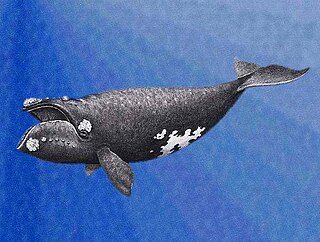
The North Pacific right whale is a very large, thickset baleen whale species that is extremely rare and endangered.
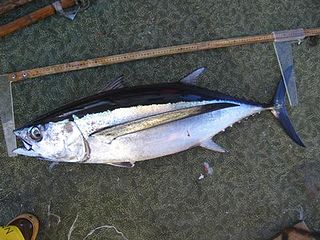
The albacore, known also as the longfin tuna, is a species of tuna of the order Scombriformes. It is found in temperate and tropical waters across the globe in the epipelagic and mesopelagic zones. There are six distinct stocks known globally in the Atlantic, Pacific, and Indian oceans, as well as the Mediterranean Sea. The albacore has an elongate, fusiform body with a conical snout, large eyes, and remarkably long pectoral fins. Its body is a deep blue dorsally and shades of silvery white ventrally. Individuals can reach up to 1.4 m in length.

Dall's porpoise is a species of porpoise endemic to the North Pacific. It is the largest of porpoises and the only member of the genus Phocoenoides. The species is named after American naturalist W. H. Dall.

The four-toothed whales or giant beaked whales are beaked whales in the genus Berardius. They include Arnoux's beaked whale in cold Southern Hemispheric waters, and Baird's beaked whale in the cold temperate waters of the North Pacific. A third species, Sato's beaked whale, was distinguished from B. bairdii in the 2010s.
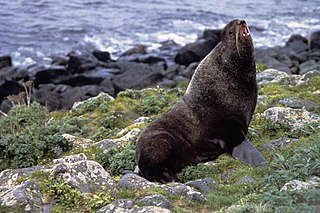
The northern fur seal is an eared seal found along the north Pacific Ocean, the Bering Sea, and the Sea of Okhotsk. It is the largest member of the fur seal subfamily (Arctocephalinae) and the only living species in the genus Callorhinus. A single fossil species, Callorhinus gilmorei, is known from the Pliocene of Japan and western North America.

Colossendeidae is a family of sea spiders. This family includes more than 100 species distributed among six genera. These sea spiders inhabit the deep sea mostly but are also found in shallower waters, especially in Antarctic and Arctic waters.
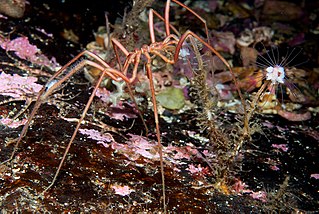
Nymphonidae is a family of sea spiders which has representatives in all the oceans. This family contains some 250 species, most of which are found in the genus Nymphon. Nymphonid bodies are between 1 and 15 mm long, the extent between the points of the legs reaching 150 mm. Most species are predators of hydroids. Like most sea spiders, species in this family have four pairs of legs, except for Pentanymphon antarcticum, which has five pairs, and Sexanymphon mirabilis, which has six pairs.

The Pacific ocean perch, also known as the Pacific rockfish, rose fish, red bream or red perch, is a fish whose range spans across the North Pacific : from southern California around the Pacific rim to northern Honshū, Japan, including the Bering Sea. The species appears to be most abundant in northern British Columbia, the Gulf of Alaska, and the Aleutian Islands.

Scorpaena is a widespread genus of marine ray-finned fish belonging to the family Scorpaenidae, the scorpionfishes.

The shortspine thornyhead, also known as the channel rockcod, shortspine channel rockfish or spinycheek rockfish, is a species of marine ray-finned fish belonging to the subfamily Sebastinae, the rockfishes, part of the family Scorpaenidae. It is sometimes referred to as the "idiot fish" or "idiot cod" due to its large oversized head and eyes. It is found in the northern and northeastern Pacific Ocean.
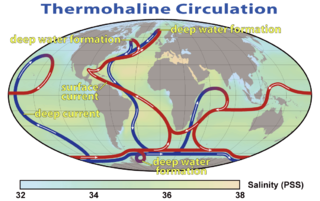
The following outline is provided as an overview of and introduction to Oceanography.

Nymphon is a genus of sea spiders in the family Nymphonidae. The species of sea spiders within the genus Nymphon are all benthic organisms and are found in abyssal and bathyal areas of the ocean. This is a fully marine group and can be found at various depths ranging from the littoral zones to the deep sea. They are found in most major oceans across the globe with a strong distribution around polar regions: Arctic and Antarctic waters. Out of the sea spider genus, Nymphon is the most rich, with a majority of the species within the genis being found in the Southern Ocean region. This genus may also contain bioluminescent species.

Pycnogonum is a genus of sea spiders in the family Pycnogonidae. It is the type genus of the family.

Achelia is a genus of pycnogonids in the family Ammotheidae.

Tanystylum is a genus of pycnogonids in the family Ammotheidae.
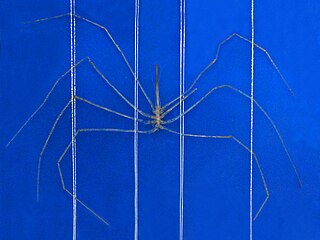
Colossendeis is a genus of sea spider belonging to the family Colossendeidae. Phylogenetic analysis based on molecular data indicates that this genus is paraphyletic with respect to the genera Decolopoda and Dodecolopoda, which are found to be nested within the genus Colossendeis in a phylogenetic tree.

Phoxichilidium is a genus of sea spiders within the family Phoxichilidiidae. Members of this genus can be found in all oceans at depths up to 1074 meters.
















